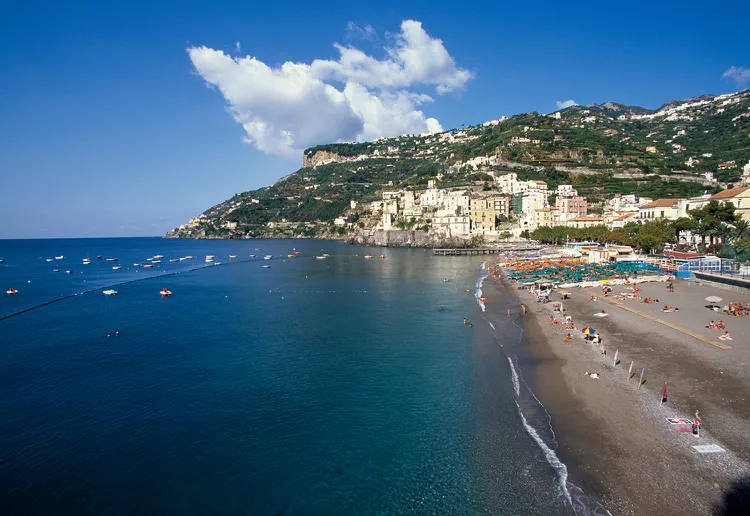Your Guide to Experiencing Italy’s Food, Festivals, and Beaches
Fact checked by
Michelai Graham
If you like sun and heat, summer may be the best time to visit Italy, when you can expect lots of both! During summertime in Italy, you can enjoy plenty of bright sunshine, visit one of its many beaches, partake in a summer festival, attend outdoor concerts and plays, and have more hours of daylight for pursuing your many adventures.
Summer is the height of tourist season in popular cities like Rome, Florence, and Venice. These cities offer rich cultures and fine dining experiences that allow visitors to truly see and taste the beauty of Italian living. However, keep in mind that in these cities, as with most places in Italy, you have to spend a lot of time outdoors to explore them properly. Many museums are not air-conditioned, so ducking into a museum might not be a guaranteed way to cool off. Therefore, if air-conditioning is a necessity for you, be sure to find a hotel that offers this amenity. Most hotels, even budget ones, provide it now, but it’s essential to verify—some may charge extra for the service.
Summer temperatures in Italy, especially in the south, can rise above 100 degrees for days in a row. The climate is generally dry, but central and northern Italy can be humid, and afternoon thunderstorms are not uncommon. To escape the heat, visitors can head to the beaches or mountains—be sure to check Italy Travel Weather before you begin packing for your trip.
Packing For Summer in Italy
There’s no getting around the fact that Italian cities can be stifling hot in the summer. Consequently, it’s important for tourists to pack for the seasonal heat as well as be prepared for sudden summer showers and thunderstorms that can occur.
You’ll want to bring a lightweight sweater and rain jacket—especially if you’re heading to the mountains—as well as a bathing suit, sandals, and a few long-sleeved shirts. Since Italian men and women generally don’t wear shorts around town except at the beach, you’ll want to bring some breathable pants for your adventures in the cities as well. If you do choose to wear shorts, they should be modest and not overly short. This guideline applies to both women and men.
There are a number of outdoor performances, festivals, museums, and tourist sites, so be sure to pack a variety of clothing, largely depending on your planned activities during your trip. Festival clothing can be informal and should be lightweight and cool, as most festivals take place outdoors. Remember that many religious sites, including the Vatican Museums in Rome, have strict dress codes and will not allow entry if you are wearing shorts, miniskirts, or sleeveless shirts.
Summer Festivals in Italy
Everywhere from the biggest cities to the tiniest villages, you’ll find festivals all across Italy during the summer. From world-famous events, like the Palio horse race in Siena, to summer concert series and medieval festivals, there’s no shortage of traditional and cultural events across the country.
Major performing arts festivals include Umbria Jazz in Perugia and the Festival dei Due Mondi in Spoleto. You can often find outdoor music and opera performances in the main squares of towns or at historic venues, such as the Roman Arena in Verona.
On August 15, Ferragosto (Assumption Day), is a national holiday, and many businesses and shops close. You’ll find celebrations throughout Italy, often including music, food, and fireworks. In large cities like Rome and Milan, however, the city empties out as Italians head for the beaches and mountains, resulting in many shops and restaurants being closed for vacation.
Italy’s Beaches and Food in Summer
Italy’s beaches become very crowded on Sundays and during July and August, making summer the high season for hotels near the sea. However, most seaside towns feature private beach clubs, known as stabilimenti, where you pay a fee that usually secures you a clean beach, a dressing room for your belongings, a lounge chair, a beach umbrella, and access to a good swimming area, toilets, and a bar.
Additionally, play areas for children, often featuring small carnival-type rides, open in the summer. Near popular beaches, you will find bars and seafood restaurants with outdoor seating, along with small shops selling beach supplies and souvenirs. During summer, many seaside towns are connected by frequent ferries.
Summer also brings a bounty of delicious fresh vegetables and fruits to many towns and cities in Italy, best enjoyed at the peak of their growing season. Look for posters announcing a sagra (local fair) celebrating a particular food—it’s an inexpensive way to sample local specialties. Of course, summer is the ideal time to enjoy gelato, Italian ice cream, while classic Italian staples are available year-round.
Although summer in Italy brings a diverse selection of seasonal crops, each season has its own unique flavor profile. Therefore, if you’re unsure which season is best for your travels, consider checking out highlights of each season to get a sense of when Italy’s native fruits and vegetables are ready for harvest!





